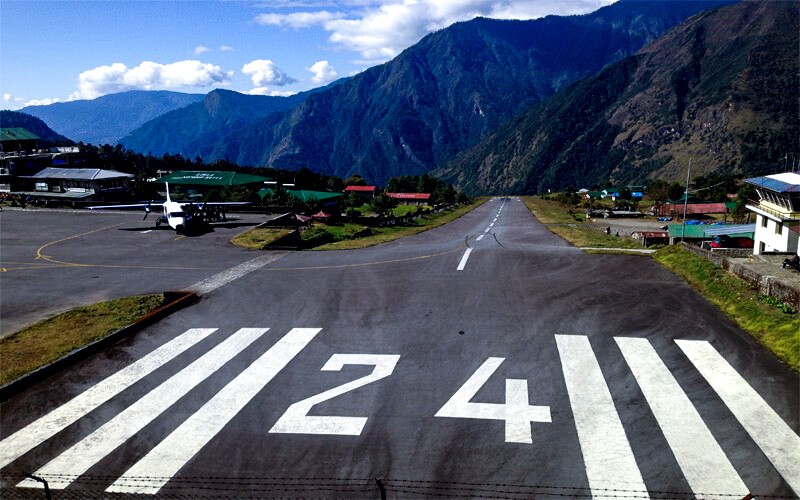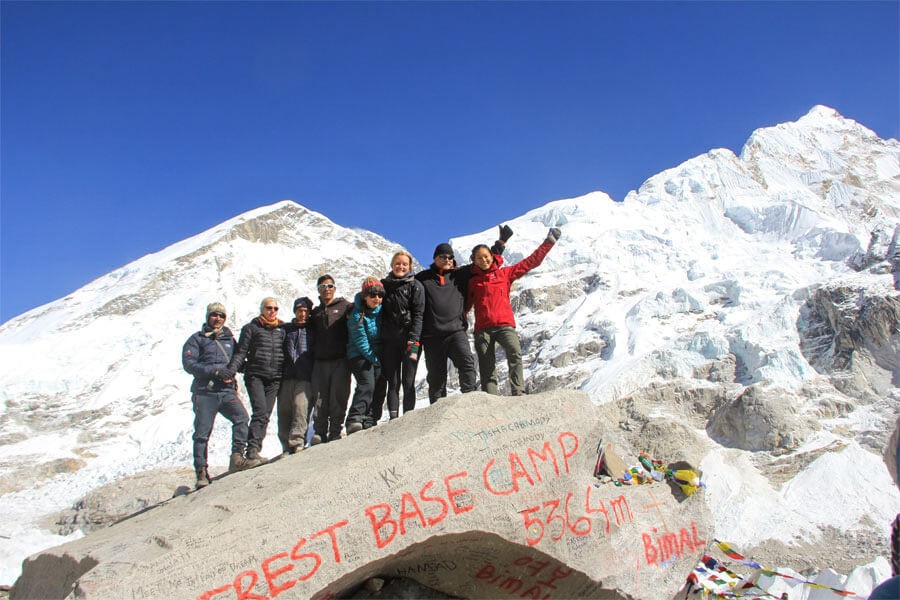Everest Base Camp
A classic Everest base camp trek on the south face of Everest is one of the most popular trekking routes in the Nepalese Himalayas. During the high trekking seasons, thousands of trekkers visit the base camp yearly. There are several ways to access the base camp, but people usually fly to Lukla from Kathmandu to save time and energy.
After landing at Lukla with a small aircraft, a few hours of hiking followed the Dudhkoshi River valley to Phakding. The same trail leads another day to the beautiful Sherpa village of Namche Bazar. The route includes different villages, suspension bridges, and tea houses. The Sagarmatha National Park starts from Monjo, where federal park entry permits are checked. After around an hour's hike from this checkpoint, Namche Bazaar arrives.
Namche Bazaar has many lovely shops, coffee shops, bars, and much more to hang around, and it supplies scenic Mountain Views of Kongde Ri, Thamserku, Kusum Kangaroo, and more. This is where all the trekkers take two days for the acclimatization practice and hike to the Everest View Hotel and enjoy the Himalayas, including Everest, Amadablam, Thamserku, Lhotse, and other high mountains.
Leaving Namche bazaar behind, the trail follows towards Tengboche, which has a beautiful course and a spectacular view of Amadablam, Everest, Lhotse, Khangteka, and other peaks. The trail descends from Sanasa, from where one route goes to Gokyo Valley. The Dudhkoshi river comes from Gokyo lakes which stays behind after crossing it from Phunki Tenga, the trail ascends to Tengboche. Tengboche is an open hill station with a famous historic old Buddhist monastery, and it supplies scenic Everest massif.
The trail descends for a few minutes to Dingboche, then ascends gradually following the Imja river valley to Dingboche, passing Pangboche and Somare and reaching Dingboche. Here is another acclimatization stop the next day. To explore the day, hike up to Nagar-Tsang hill or Chhukung towards the Island's peak.
About a 5-6 hours walk from Dingboche, crossing Thukla tea shops and Thukla Pass, where the monuments of the death climbers are, arrives at Lobuche. Lobuche is in a valley with a 4910m elevation above sea level. A giant Nuptse Lobuche peak can be seen here, and there will be enough time to explore the Khumbu glacier.
The final day with a big goal is visiting the leading destination (Everest Base Camp). Walking through the Khumbu valley, crossing Lobuche Pass and glacier, Gorakshep reached. Take about an hour's break here and have a quick lunch or snack, then hike to the base camp, which takes around 2-3 hours one way. The trail along the way is primarily rocky and windy. This place will be like a small mountain city during the primary climbing season (spring).
Best routes to Everest
Visiting Everest base camp is not the only way. There are several routes, but flying to Lukla with a small aircraft is a quick and easy way that most trekkers use. However, driving to Jiri by bus or Salleri by jeep and walking for about a week more than taking a flight to Lukla is also possible for those who have a more extended holiday. A Helicopter flight to the base camp is another luxury option for people who have only one day to explore the Everest region in a few hours.
Best Time to Visit Everest
The autumn (September – December) and spring (March- May) are the best times to do the Everest base camp trek. These are the primary trekking season in Nepal. Usually, the weather is clear during these seasons for the tour. Spring is the primary expedition season for Mt. Everest, so hundreds of climbers will be ready at the base camp to win the most adventurous mountain sport. There are significantly fewer trekkers during winter because of the cold and summer because of clouds and less chance to fly into Lukla, so autumn and spring are highly recommended.
Weather and Temperature in EBC
Winter (December – February) is cold, so trekking during these months is the most challenging. I recommend hot trekking gear. The temperature is high, but the view is still good. Spring is warmer than autumn, but both seasons are perfect for Everest base camp treks. Summer is warm, but the weather is unclear and will be rainy.
Minimum Temperature of 12 Months (In Average):
- January - (-20 Degree Celsius)
- February – (- 18 Degrees Celsius)
- March – (-14.5 Degree Celsius)
- April – (-9 Degrees Celsius)
- May – (-5.5 Degree Celsius)
- June – (-1 Degree Celsius)
- July – (1 Degree Celsius)
- August – (0 Degree Celsius)
- September – (-3 Degree Celsius)
- October – (-9 Degree Celsius)
- November – (-15 Degree Celsius)
- December – (-18 Degree Celsius)
Lodge and Food Facilities
The lodge's facilities and food are well organized during the Everest base camp trek from Jiri, Salleri, or Lukla. Several tea houses have a private room every half hour or at every stop. Most tea houses have standard rooms with shared bathrooms, but some lodges have attached bathrooms. There are also luxury hotels in some places.
The visitors may think they must have the local Nepalese foods during the trek. It is not valid; the tea houses have the same food menu, but mostly the same items everywhere, which primarily trained cooks cook, but in some places, the chefs are well trained. Having meat items during the trek may cause a problem of food poisoning somebody, so it is better to be safe being vegetarian until the tour. Drinking regular water using purifying tablets, sterilizers, or other medication is also okay; you can buy bottled water. However, the water may be dusty for a few days in the higher area, so buying bottled water is recommended.
View from the Base Camp
Everest is blocked by Mt. Lola (west soldier) and Nuptse, but they can see Everest on the way to the base camp. The view of other high mountains like Nuptse, Lola, Pumori, Lingtren, Khumbutse, and the Tibetan mountain Changatse are nice to see from here. Under the base camp is all ice, so the base camp is on the glacier. Khumbu icefall, which the climbers cross during the expedition, is very near. There is no massive sign at the base camp; there is just some writing on the big rock and Tibetan prayer flags.
Sleeping at the Base Camp
There are no lodges at the base camp, so sleeping is impossible. However, if people have tents and sleeping gear, they can sleep here with dry food or cook it themselves; otherwise, only the climbers sleep at the base camp. For regular trekkers, Gorakshep is the place to sleep, hike to the base camp, and return to the lodge.
If you like this article, visit our Everest base camp trek main package page and contact us. We are here to provide more information and arrange your Everest base camp tour at a reasonable cost and with the best hospitality.









